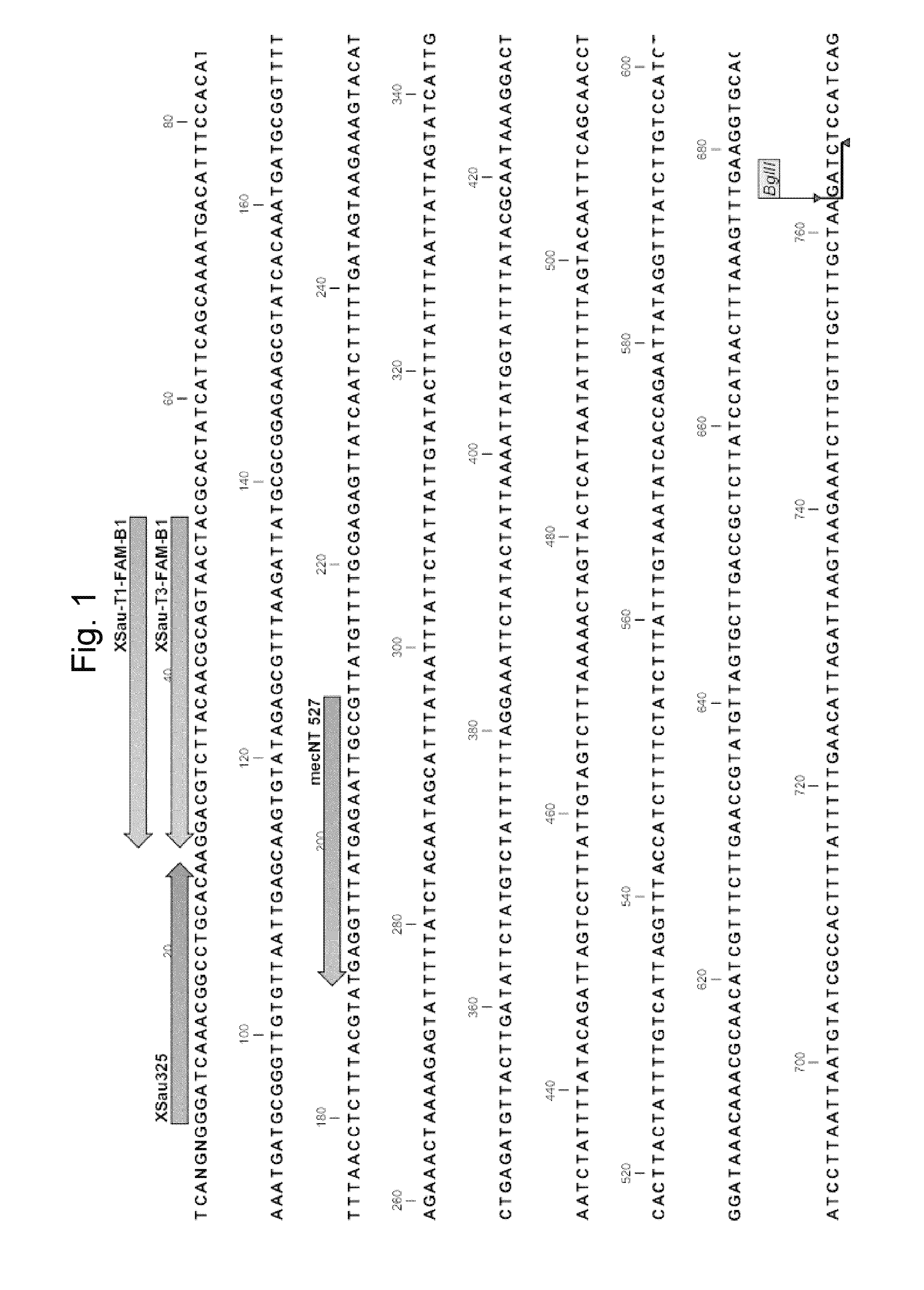Sequences for detection and identification of methicillin-resistant staphylococcus aureus (MRSA) of mrej type xxi
a staphylococcus aureus and methicillin-resistant technology, applied in the field of molecular diagnostic tools for the detection of methicillin-resistant staphylococcus aureus, can solve the problems of high morbidity and mortality, mrsa infections can only be treated with toxic and more costly antibiotics, and antimicrobial susceptibility testing
- Summary
- Abstract
- Description
- Claims
- Application Information
AI Technical Summary
Benefits of technology
Problems solved by technology
Method used
Image
Examples
example 1
Detection and Identification of MREJ Type XXI MRSA from Clinical Samples
[0105]A qPCR reaction to detect and identify MRSA having MREJ type xxi nucleic acids is performed. Clinical samples are collected from patients using Amies liquid swabs (Copan Diagnostics, Inc).
[0106]DNA is optionally isolated from the clinical samples using the BD GeneOhm™ Lysis kit (Becton Dickinson) pursuant to manufacturer's instructions. A sample of the isolated DNA is contacted with primers that specifically hybridize under standard amplification conditions to S. aureus species-specific orfX sequences and to the polymorphic right extremity sequences of MREJ type xxi, i.e., 0.2-0.7 μM each of SEQ ID NOs: 2, and 3. 0.3 μM dNTPs (Roche), 4 mM MgCl2 (SIGMA), 2.8 units FASTSTART® Taq polymerase (Roche), 100 mM Tris, pH 8.3 (EMD), 10 mM KCl (LaboratoireMat), 5 mM (NH4)2SO4 (SIGMA), 0.15 mg / mL BSA (SIGMA) 4% trehalose (SIGMA). The reaction also includes molecular beacon probes that specifically hybridize to ampli...
example 2
Multiplex Detection of MREJ Types I-XXI MRSA from Clinical Samples
[0109]A multiplex amplification reaction is performed to detect the presence of MRSA having any of MREJ types i-vii, ix, xiii, xiv and xxi is performed. Clinical samples are collected from patients using Amies liquid swabs (Copan Diagnostics, Inc).
[0110]DNA is optionally isolated from the clinical samples using the BD GeneOhm™ Lysis kit (Becton Dickinson) pursuant to manufacturer's instructions. A sample of the isolated DNA is contacted with primers that specifically hybridize under standard amplification conditions to S. aureus species-specific orfX sequences and to the polymorphic right extremity sequences of MREJ type i-vii, ix, xiii, xiv and xxi and i.e., 0.2-0.7 μM each of SEQ ID NOs: 2, 3, 39, 77, and 81, 0.3 μM dNTPs (Roche), 4 mM MgCl2 (SIGMA), 2.8 units FASTSTART® Taq polymerase (Roche), 100 mM Tris, pH 8.3 (EMD), 10 mM KCl (LaboratoireMat), 5 mM (NH4)2SO4 (SIGMA), 0.15 mg / mL BSA (SIGMA) 4% trehalose (SIGMA)....
example 3
MREJ Type XXI Sequences are Associated with the mecA Homolog, mecC
[0113]PCR amplification of the MREJ type xxi region and the mecC gene was performed on 51 isolates of MRSA isolated from either bovine or human hosts.
[0114]A list of the isolates is provided in the table below:
MREJ type(confirmed byMREJStrainsequencing)HostLocationtypeIDI6121xxiBovineSomerset, EnglandxxiIDI6122xxiBovineSomerset, EnglandxxiIDI6123xxiBovineBury St Edmunds,xxiEnglandIDI6124UnknownBovineLangford, EnglandUnknownIDI6125xxiBovineBury St Edmunds,xxiEnglandIDI6126xxiBovineSutton Bonington,xxiEnglandIDI6127xxiBovineSutton Bonington,xxiEnglandIDI6128xxiBovineSutton Bonington,xxiEnglandIDI6129xxiBovineSutton Bonington,xxiEnglandIDI6130xxiBovineSutton Bonington,xxiEnglandIDI6131xxiBovineSutton Bonington,xxiEnglandIDI6132xxiBovineSutton Bonington,xxiEnglandIDI6133xxiBovineSutton Bonington,xxiEnglandIDI6134xxiBovineThirsk, EnglandxxiIDI6135xxiHumanTayside, ScotlandxxiIDI6136xxiHumanLothian, ScotlandxxiIDI6137xxiHuma...
PUM
| Property | Measurement | Unit |
|---|---|---|
| Tm | aaaaa | aaaaa |
| Tm | aaaaa | aaaaa |
| Tm | aaaaa | aaaaa |
Abstract
Description
Claims
Application Information
 Login to View More
Login to View More - R&D
- Intellectual Property
- Life Sciences
- Materials
- Tech Scout
- Unparalleled Data Quality
- Higher Quality Content
- 60% Fewer Hallucinations
Browse by: Latest US Patents, China's latest patents, Technical Efficacy Thesaurus, Application Domain, Technology Topic, Popular Technical Reports.
© 2025 PatSnap. All rights reserved.Legal|Privacy policy|Modern Slavery Act Transparency Statement|Sitemap|About US| Contact US: help@patsnap.com

